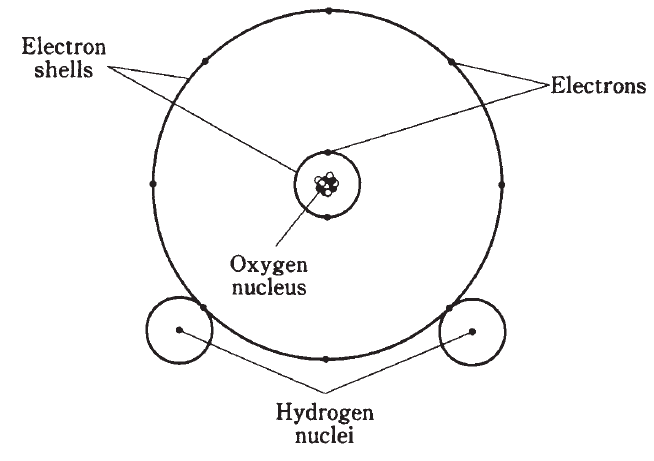
Molecules
 المؤلف:
Stan Gibilisco
المؤلف:
Stan Gibilisco
 المصدر:
Teach Yourself Electricity and Electronics
المصدر:
Teach Yourself Electricity and Electronics
 الجزء والصفحة:
10
الجزء والصفحة:
10
 29-3-2021
29-3-2021
 1922
1922
Molecules
When atoms of elements join together to form a compound, the resulting particles are molecules. Figure 1 is an example of a molecule of water, consisting of three atoms put together.
The natural form of an element is also known as its molecule. Oxygen tends to occur in pairs most of the time in the earth’s atmosphere. Thus, an oxygen molecule is sometimes denoted by the symbol O2. The “O” represents oxygen, and the subscript 2 indicates that there are two atoms per molecule. The water molecule is symbolized H2O, because there are two atoms of hydrogen and one atom of oxygen in each molecule.

Figure 1: Simplified diagram of a water molecule.
Sometimes oxygen atoms are by themselves; then we denote the molecule simply as O. Sometimes there are three atoms of oxygen grouped together. This is the gas called ozone, that has received much attention lately in environmental news. It is written O3.
All matter, whether it is solid, liquid, or gas, is made of molecules. These particles are always moving. The speed with which they move depends on the temperature. The hotter the temperature, the more rapidly the molecules move around. In a solid, the molecules are interlocked in a sort of rigid pattern, although they vibrate continuously (Fig. 2A). In a liquid, they slither and slide around (Fig. 2B). In a gas, they are literally whizzing all over the place, bumping into each other and into solids and liquids adjacent to the gas (Fig. 2C).

Figure 2: At A, simplified rendition of molecules in a solid; at B, in a liquid; at C, in a gas. The molecules don’t shrink in the gas. They are shown smaller because of the much larger spaces between them.
 الاكثر قراءة في الألكترونيات
الاكثر قراءة في الألكترونيات
 اخر الاخبار
اخر الاخبار
اخبار العتبة العباسية المقدسة


